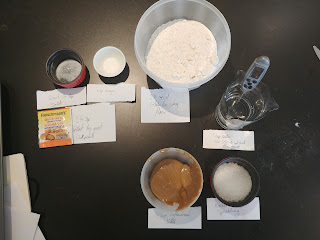Working around Allergens in your Kitchen
A
gluten-free diet is one that avoids gluten, as the name suggests. Gluten is a
protein found in wheat products which forms the main structure in these
products. This diet can be restrictive as many products include gluten,
including some that many people wouldn’t expect. A common thickening agent is a
roux, equal parts flour and butter cooked to various stages to thicken some
soups or sauces with the gluten development. This is what prevents some gravies
and soups from being gluten free, even if there isn’t an obvious source of
gluten.
Celiac Disease is an auto-immune disease which prevents the digestive system from properly handling gluten. The lining of the small intestine is structured differently. Celiac disease has been shown to be hereditary. This causes immense abdominal discomfort when gluten is eaten.
Some people decide to follow a gluten free diet because they believe that it will prevent them from being bloated. Other believes it to be inherently healthier, as it reduces the intake of carbohydrates. As you are likely eating more fruits and vegetables with a gluten free diet, it can also be attributed to lowering cholesterol, blood pressure, and lowering risk of diabetes and heart disease.
It is important to let the client know that there is always a chance of cross contamination if you are unable to keep an area quarantined. You must be able to ensure that no ingredients or prep station could have cross contamination from potential allergens. This often requires a set of tools or area that is only used for allergen friendly products. Keeping soap and water readily available to wash down tables, and then follow with sanitizer is a base step to ensure that there is no cross contamination. Keeping foods store in airtight containers, which are cleaned and labeled, if contents change, is also essential.
I made gluten-free, vegan pretzel bites, which turned out better than I expected, considering how gluten free bread products go.
When it has risen as much as desired, divide and shape into balls. This recipe should yield about 36.
Brush with half of your sesame seed oil, and pop into the oven at 425F for 12 minutes.
They may not brown on top, and have a chewy centre.
While still warm, toss in remaining oil, and kosher salt, as desired.
From making this recipe, I got a more hands on experience on how to work with gluten free flours. When kneading in with a well, you want to add the water in smaller amounts, allowing for a more even distribution. Vegan butters do not have the same melt point that I'm used to, and I wish I had done more research on that before hand. I am lucky that I had a substitute on hand.
Gluten Free flours require more binding agents, which changed the expected consistency. Adapting them to pretzel bites instead of pretzels allows for them not to dry out as much, and keep their shape better.
If I were to make this recipe again, I would consider adding more xanthan gum, in addition to what is already in the flour mix I used. I would also like to try using a different fat to help stick the salt to the bites, as the ideal of using a butter is that it will solidify as the product cools and help the salt stay put
Celiac Disease is an auto-immune disease which prevents the digestive system from properly handling gluten. The lining of the small intestine is structured differently. Celiac disease has been shown to be hereditary. This causes immense abdominal discomfort when gluten is eaten.
Some people decide to follow a gluten free diet because they believe that it will prevent them from being bloated. Other believes it to be inherently healthier, as it reduces the intake of carbohydrates. As you are likely eating more fruits and vegetables with a gluten free diet, it can also be attributed to lowering cholesterol, blood pressure, and lowering risk of diabetes and heart disease.
It is important to let the client know that there is always a chance of cross contamination if you are unable to keep an area quarantined. You must be able to ensure that no ingredients or prep station could have cross contamination from potential allergens. This often requires a set of tools or area that is only used for allergen friendly products. Keeping soap and water readily available to wash down tables, and then follow with sanitizer is a base step to ensure that there is no cross contamination. Keeping foods store in airtight containers, which are cleaned and labeled, if contents change, is also essential.
I made gluten-free, vegan pretzel bites, which turned out better than I expected, considering how gluten free bread products go.
- 2 1/2 cups gluten free baking flour
- 2 1/4 tsp instant dry yeast (one 1oz, or 8g, packet)
- 1 tsp sugar
- scant 1/4 tsp salt
- 2 cups of warm water (ensuring your water isn't so hot it kills the yeast)
- 1/4 cup sesame seed oil (pictured is sunflower seed butter, which I couldn't get to work for the application need, unfortunately)
- Kosher salt (to taste, for sprinkling on top)
Begin by mixing your dry ingredients together.
Add your warm water.
Knead until it all comes together, and is an even consistency.
Cover, and allow to rise for at least 45mins.
When it has risen as much as desired, divide and shape into balls. This recipe should yield about 36.
Brush with half of your sesame seed oil, and pop into the oven at 425F for 12 minutes.
They may not brown on top, and have a chewy centre.
While still warm, toss in remaining oil, and kosher salt, as desired.
From making this recipe, I got a more hands on experience on how to work with gluten free flours. When kneading in with a well, you want to add the water in smaller amounts, allowing for a more even distribution. Vegan butters do not have the same melt point that I'm used to, and I wish I had done more research on that before hand. I am lucky that I had a substitute on hand.
Gluten Free flours require more binding agents, which changed the expected consistency. Adapting them to pretzel bites instead of pretzels allows for them not to dry out as much, and keep their shape better.
If I were to make this recipe again, I would consider adding more xanthan gum, in addition to what is already in the flour mix I used. I would also like to try using a different fat to help stick the salt to the bites, as the ideal of using a butter is that it will solidify as the product cools and help the salt stay put




Comments
Post a Comment